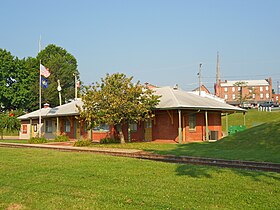
The Old Mauch Chunk Historic District is a national historic district located at Jim Thorpe, Carbon County, Pennsylvania. The district includes 28 contributing buildings in the central business district of Jim Thorpe. It includes residential and commercial buildings in a number of popular architectural styles including Italianate. The original town was laid out in 1831 by noted civil engineer John A. Roebling. Notable buildings include The I.O.O.F. Hall (1844), Lehigh Coal and Navigation Building (1882), Jim Thorpe National Bank (1870s), Carbon County Courthouse (1894), Dimmick Memorial Library (1889), Capitol Theater (1882), 1855 School, Weiksner's Taproom (1860s), "Stone Row," Webster House, New American Hotel, and Hooven Mercantile Building. Located in the district and listed separately are the Asa Packer Mansion, Harry Packer Mansion, Carbon County Jail, Central Railroad of New Jersey Station, and St. Mark's Episcopal Church.

Roaring Spring Historic District is a national historic district located at Roaring Spring, Blair County, Pennsylvania. The district includes 573 contributing buildings, 3 contributing sites, and 2 contributing structures in the central business district and surrounding residential areas of Roaring Spring. The earliest buildings date to the 1860s, when the community was founded as the region's first paper mill town. The buildings are primarily frame and brick, with notable examples of Colonial Revival and Queen Anne style architecture. Notable non-residential buildings include the Odd Fellows Hall (1882), Hite's Furniture Store, Roaring Spring Bank (1902), old Borough Building and Fire Station (1906), Zook Building, Bare Memorial Church of God (1889-1930), Trinity United Methodist Church (1898), Blank Book Company buildings, and Roaring Spring Passenger Station. Also located in the district are the Bare Memorial Fountain (1937) and Greenlawn Cemetery and Memorial Park.

Bellefonte Historic District is a national historic district located at Bellefonte, Centre County, Pennsylvania. The district encompasses 296 contributing buildings in the central business district and surrounding residential area of Bellefonte. The oldest building in the district is the Col. James Dunlop House dated to 1795. Notable non-residential buildings include the St. John's Roman Catholic Church, Crider Exchange (1889), Temple Court Building (1894), First National Bank Building, W.F. Reynolds and Co. Bank Building, and Pennsylvania Railroad Station. Located in the district and listed separately are the Brockerhoff Hotel, Centre County Courthouse, Gamble Mill, McAllister-Beaver House, and Miles-Humes House. The Bellefonte Academy and the Bush House Hotel were previously listed on the register until they burned to the ground in 2004 and 2006, respectively.

Woodvale Historic District is a national historic district located at Broad Top Township, Bedford County; Wells Township, Fulton County; and Wood Township, Huntingdon County, Pennsylvania. The district includes 79 contributing buildings, 1 contributing site, and 2 contributing structures in the coal mining community of Woodvale. The buildings date between about 1890 and 1942, and include industrial buildings, institutional buildings, and vernacular worker's housing. They were built by the Rockhill Iron and Coal Company. Non-residential buildings include the Methodist Church (1911), St. Michael's Greek Orthodox Church (1930s), a social hall, a mule barn, power house, railroad machine shop (1918), and post office (1919).

Cambria City Historic District is a national historic district located at Johnstown in Cambria County, Pennsylvania. The district includes 198 contributing buildings and 1 contributing structure in a predominantly working-class residential area of Johnstown. Though predominantly residential, it also includes a small business district and industrial buildings such as a former brewery, bottling plant, and slaughter house, along with a notable collection of churches, schools, and fire station. The district includes some buildings dated before the Johnstown Flood, but the majority date from 1890 to 1920. Notable buildings include the collection of two-story, balloon frame, detached and semi-detached dwellings, Fifth Avenue Hotel (1889), Pollack Building (1905), former Cambria Fire Hose and Ladder Company (1890), former Germana Brewery (1907), August and Louisa Mayer Building (1907), Tulip Bottling Company (1913-1949), St. Casimer's Polish Church (1907), Immaculate Conception Church (1908), St. Stephen's Slovak Church (1914), St. Columba Church (1914), St. Mary's Greek Catholic Church (1922), Venue Of Merging Arts, Hungarian Reformed Church (1902), and First Catholic Slovak Band Hall (1913-1949). The contributing structure is the Minersville Bridge (1914).
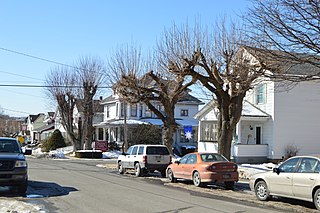
Portage Historic District is a national historic district located at Portage in Cambria County, Pennsylvania. The district includes 561 contributing buildings and 5 contributing structures in the central business district and surrounding residential areas of Portage. Most of the buildings were built between 1900 and 1925, with the oldest dated to the 1870s. Notable non-residential buildings include the Pennsylvania Railroad freight station, Pennsylvania Railroad passenger station, Palmer Feed Mill, Pearce Building (1914), Central Hotel, Century Ribbon Mill (1906-1911), Portage Bronze Electric Company, First Lutheran Church (1872), S. Michael's Orthodox Church (1915), and Hungarian Hall.
Glen Rock Historic District is a national historic district located at Glen Rock in York County, Pennsylvania. The district includes 287 contributing buildings, 1 contributing site, and 4 contributing structures in the central business district and surrounding residential area of Glen Rock. The houses are mostly 2+1⁄2-story, vernacular wood-frame buildings, built between 1838 and 1945, with some notable Queen Anne and Bungalow/craftsman style dwellings. Notable buildings include the Philip Shaffer House, the "Castle" (1889), Peoples Bank of Glen Rock (1912), Glen Theatre (1913), Glen Rock Hose and Ladder Company (1904), Zion Evangelical Lutheran Church (1905), Immanuel United Methodist Church (1926), Industrial Sewing Company (1916), Glen Traditionals building (1921), and Accufab building. A contributing structure is the Northern Central Railway bridge.

Mercersburg Historic District is a national historic district centered on the center square of Mercersburg in Franklin County, Pennsylvania. The district includes 124 contributing buildings and 1 contributing site in the central business district and surrounding residential areas of Mercersburg. The residential buildings include a number of sheathed log, stone, and brick dwellings, with some dating to the 18th century. The district has a number of notable examples of the Federal, Greek Revival, and Colonial Revival styles.
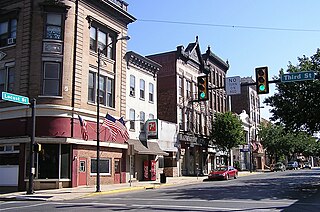
Columbia Historic District is a national historic district located at Columbia, Lancaster County, Pennsylvania. The district includes 833 contributing buildings, 2 contributing sites, and 7 contributing structures in the central business district and surrounding residential areas of Columbia. The district is primarily residential with notable examples of Late Victorian architectural styles. Notable non-residential buildings include the Reading and Columbia Freight Station (1883), Holy Trinity Catholic Church and School (1915), American Legion Post 469, Women's Club, Columbia Lodge #1074 BPOE, Columbia Town Hall, St. Paul's Episcopal Church (1888), Franklin Hotel, and Columbia Water Company. Located in the district is the separately listed Bachman and Forry Tobacco Warehouse.

Marietta Historic District is a national historic district located at Marietta, Lancaster County, Pennsylvania. The district includes 373 contributing buildings in the central business district and surrounding residential areas of Marietta. The district includes notable examples of the Italianate and Federal architectural styles. Notable buildings include the Duffy House, Marietta Community Center, Shelly House, the Pierre de Vittry House, Marietta Theater, First Farmers' Bank, David Smith House, English Presbyterian Church, Liquor Control Board Office, the Railroad Hotel, Union House Gallery, Eckmans Hotel, White Swan Inn, Henry Musselman House, former Grove Hotel, and the Old Town Hall.

Tamaqua Historic District is a national historic district located at Schuylkill Township and Tamaqua, Schuylkill County, Pennsylvania. The district includes 944 contributing buildings, 3 contributing sites, 8 contributing structures, and 3 contributing objects in the central business district and surrounding residential areas of Tamaqua. The residential buildings principally date to the early 20th century. They are mostly two-story, of brick and frame construction, and in a variety of popular architectural styles including Queen Anne, Late Victorian, Italianate, and Colonial Revival. Notable non-residential buildings include the Little Schuylkill Hotel (1827), White Swan, Washington House, Shepp Building, Elks Lodge, Peoples Trust Company Building, Tamaqua National Bank (1908), First National Bank of Tamaqua, U.S. Post Office (1932), Majestic Theater and Hotel, Hegarty Blacksmith Shop (1848), Conrad Biscoff Planing Mill and Furniture Factory (1865), Tamaqua Manufacturing Company (1910), Calvary Episcopal Church (1851), First Methodist Church (1852), St. Jerome's Roman Catholic Church (1856), American Hose Company (1881), East End Fire Co. (1923), and the former Tamaqua Armory. The contributing sites are St. Jerome's Cemetery, Odd Fellows Cemetery (1865), and the foundation of the Fitzpatrick Shirt Factory (1888). Contributing structures include three runs of iron steps and five bridges. Located in the district and separately listed are the Anthracite Bank Building, George Ormrod House, and Tamaqua Railroad Station.

Lewisburg Historic District is a national historic district located at Lewisburg, Union County, Pennsylvania. The district includes 853 contributing buildings, 2 contributing sites, 11 contributing structures, and 2 contributing objects in the central business district and surrounding residential areas of Lewisburg. Notable buildings include the Derr House (1773), 19th century and early-20th century Bucknell University buildings including Old Main and Bucknell Hall, Union County Courthouse (1856), U.S. Courthouse and Post Office (1933), Himmelreich Library (1902), First Presbyterian Church (1856), Christ Lutheran Church (1901), Union National Bank (1899), McClure Building (1913), Campus Theatre (1939), and the Buffalo Mills (1883). Also located in the district are the separately listed Chamberlin Iron Front Building, Packwood House-American Hotel, and Reading Railroad Freight Station. Contributing sites are the Lewisburg Cemetery and Soldiers Memorial Field. The contributing structures include five railroad bridges and the contributing objects are the Soldiers Memorial Monument (1901) and a commemorative plaque.
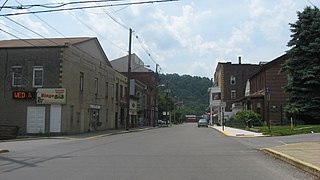
Emlenton Historic District is a national historic district located at Emlenton, Venango County, Pennsylvania. The district includes 317 contributing buildings, 57 contributing structures, and 1 contributing object in the central business district and surrounding residential areas of Emlenton. It includes commercial, residential, industrial, and institutional buildings. They are in a variety of popular architectural styles including Italianate, Greek Revival, and Gothic Revival.

Ligonier Historic District is a national historic district located at Ligonier, Westmoreland County, Pennsylvania. It encompasses 419 contributing buildings, 2 contributing sites, 1 contributing structure, and 1 contributing object in the central business district and surrounding residential areas of Ligonier. They were built between about 1790 and 1944, and includes a mix of residential, commercial, institutional, and industrial properties. They are in a variety of popular architectural styles including Federal and Late Victorian. Notable buildings include the E.T. Weller House (1907), Ligonier Valley Railroad Station (1909), United Presbyterian (Pioneer) Church (1876), Covenant Presbyterian Church (1902), Heritage United Methodist Church (1903), and the former Municipal Building (1937). The district includes the separately listed Fort Ligonier Site and demolished Ligonier Armory.

Mount Pleasant Historic District is a national historic district located at Mount Pleasant, Westmoreland County, Pennsylvania. It encompasses 268 contributing buildings, 1 contributing site, and 1 contributing object in the central business district and surrounding residential areas of Mount Pleasant. They were built between about 1812 and 1948, and includes a mix of residential, commercial, institutional, and industrial properties. They are in a variety of popular architectural styles including Italianate, Queen Anne, and Colonial Revival. Notable buildings include the Overholt General Store, harness shop, warehouse, East End Hotel, Grand Central Hotel, Gerechter Furniture Building, Citizens Savings and Trust Company and First National Bank (1905), Shupe Steam Grist Mill (1843), City Hall (1910), Penn Theater (1937), Reunion Presbyterian Church (1873), Wesley United Methodist Church (1856), Transfiguration Roman Catholic Church (1889), and three houses built about 1812. The contributing site is Frick Park. The district includes the separately listed Samuel Warden House and demolished Mount Pleasant Armory.

Titusville Historic District is a national historic district in Titusville, Crawford County, Pennsylvania.

Morgantown Historic District, also known as Old Main Street Historic District, is a national historic district located in Caernarvon Township, Berks County, Pennsylvania. The district encompasses 104 contributing buildings, 1 contributing structure, and 1 contributing object in the village of Morgantown built between about 1790 and 1945. It includes residential, commercial, and institutional buildings in a variety of popular architectural styles including Georgian and Late Victorian. The oldest buildings are mostly built of brown sandstone. A primarily residential district, notable non-residential buildings include a tavern / hotel, I.O.O.F. lodge / town meeting hall (1868), Morgantown Garage (1920), and fire hall (1921). Also in the district are a contributing cemetery and war memorial.

Butler Historic District is a national historic district located at Butler, Butler County, Pennsylvania. The district includes 128 contributing buildings, 1 contributing site, and 4 contributing objects in the central business district of Butler. It includes primarily commercial and institutional buildings, with some residential buildings, built between about 1828 and 1952 in a number of popular architectural styles including Late Victorian. Notable buildings include the City Hall, former U.S. Post Office (1912), Koch Building, T.W. Phillips Co. Office Building, Masonic Temple (1910), Butler High School (1917), Butler YMCA (1895), Butler YMCA (1913), First Evangelical Lutheran Church (1897), St. Andrews United Presbyterian Church, John Quincy Adams Kennedy House, St. Mark's Evangelical Lutheran Church and School, First Baptist Church (1914), St. Paul's Roman Catholic Church (1909), and Butler Savings and Trust (1925). The contributing site is the Diamond, that contains the contributing objects including the Soldiers and Sailors Monument (1894). Located in the district and listed separately are the Butler County National Bank, the Sen. Walter Lowrie House, and the Butler County Courthouse.
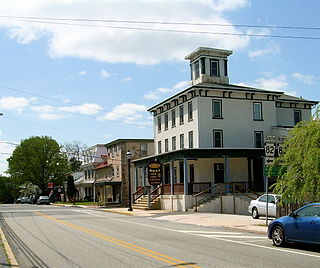
Elverson Historic District is a national historic district located in Elverson, Chester County, Pennsylvania. The district includes 133 contributing buildings, 3 contributing sites, and 4 contributing structures in the central business district and surrounding residential areas of Elverson. The district includes a variety of residential, commercial, and institutional buildings with examples of Bungalow/craftsman, Georgian, and Gothic Revival architecture. Contributing buildings date from about 1750 to about 1930. Notable buildings include "The Bank House", train station (1870), Springfield M.E. Church (1869), Blue Rock Hotel (1860), Dengler Bro. Store, Whoye Horse Tavern (1811), The Creamery (1906), and Springfield School (1873). One of the contributing structures is the railroad car "Baltimore County."

Laurel Historic District is a national historic district located at Laurel, Sussex County, Delaware. The district includes 701 contributing buildings, 5 contributing sites, 4 contributing structures, and 1 contributing object in the central business district and surrounding residential areas of Laurel. It includes residential, commercial, industrial, and institutional buildings dated from the late-18th century to the 1930s. The residential buildings are mostly frame structures in the "I-house" plan. Most commercial buildings re brick structure and date to the early-20th century. Notable non-residential buildings include the Dashiell Building, Sussex Trust Building, Mellon Bank Building, Laurel Railroad Station, firehouse (1937), the original water company building, more recent town water buildings, U.S. Post Office (1935), Centenary Methodist Church, St. Phillip's Episcopal Church the Methodist Protestant Church, and the I.O.O.F. Meeting Hall.




